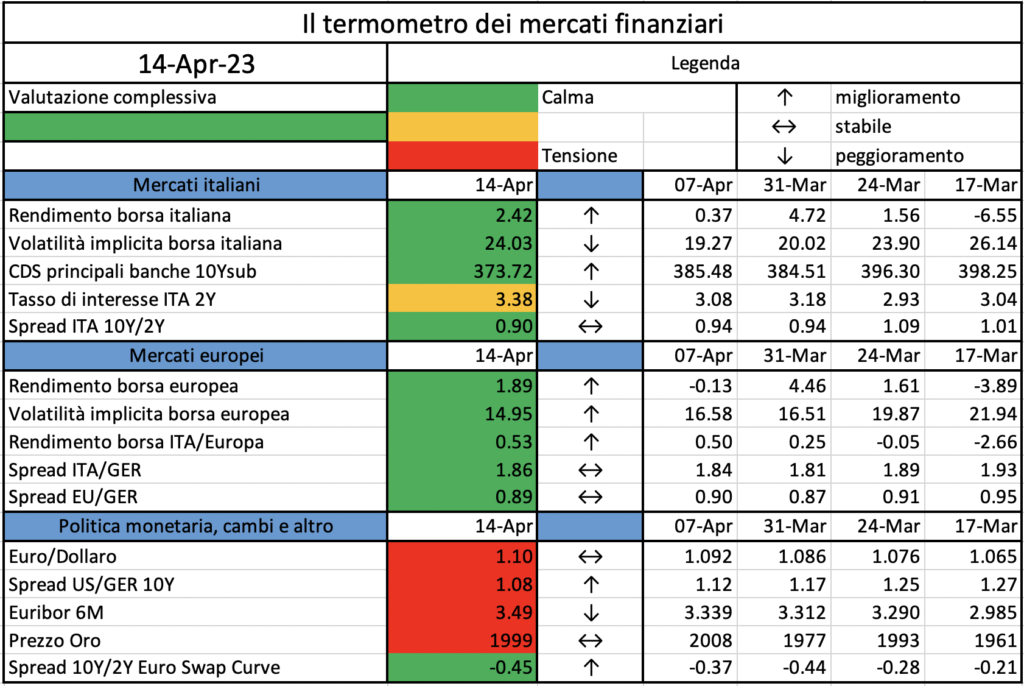S&P conferma la sua valutazione sull’Italia, mantenendo invariato il rating a BBB e l’outlook stabile. Constatando un rallentamento dell’economia nel 2023, quando il PIL è atteso crescere dello 0,4%, l’agenzia constata come la “premier Giorgia Meloni ha finora perseguito un approccio moderato e pragmatico in relazione all’Europa e alla politica di bilancio”, come mostrato dall’approvazione della manovra 2023 che ha mantenuto un grado di prudenza fiscale “in linea con il suo predecessore Mario Draghi”…
The European Securities and Markets Authority (ESMA), the EU’s financial markets regulator and supervisor, today published the third edition of its Data Quality Report under the European Markets Infrastructure Regulation (EMIR) and the Securitised Financing Transactions Regulation (SFTR) reporting regimes. The report highlights the increased use of transaction data by EU financial regulatory authorities in their day-to-day supervision…
Cyber incidents are rapidly growing in frequency and sophistication. The interconnectedness of the global financial system makes it possible that a cyber incident at one financial institution (or an incident at one of its third-party service providers) could have spill-over effects across borders and sectors…
Tempi duri per le banche centrali. Tanto maggiori sono e saranno i rischi geopolitici, tanto più forte sarà la frammentazione dell’economia globale e delle catene globali del valore in un mondo sempre più multipolare, tanto più elevata potrà essere l’inflazione. Le banche centrali indipendenti sanno cosa fare: «Di fronte a shock persistenti dell’offerta, le banche centrali indipendenti possono garantire la stabilità dei prezzi e continueranno a farlo»…

Dopo il recente dissesto della Silicon Valley Bank (SVB), e di altre banche statunitensi minori, seguito dal salvataggio della svizzera Credit Suisse e dalle turbolenze sui mercati finanziari di altri grandi player europei, in primis Deutsche Bank, molti analisti si sono interrogati se a distanza di 15 anni dal crack di Lehman Brothers siamo nuovamente di fronte ad una crisi bancaria sistemica. Ciò che da un lato rassicura è che autorità di politica monetaria e policy maker coinvolti non si sono fatti trovare impreparati come, invece, accadde nella crisi del 2007-08. In particolare, la risposta offerta dagli Usa è stata rapida ed efficace nell’arrestare un “incendio” che potenzialmente avrebbe potuto estendersi al “sottobosco” di altre banche di media dimensione. Altrettanto rapida è stata la reazione delle autorità elvetiche, anche se più discutibile nei contenuti. Infatti, la scelta di far assorbire interamente le perdite subite dal Credit Suisse ai titoli AT1, strumenti ibridi a metà tra capitale e obbligazioni, preservando invece gli azionisti, ha gettato nello scompiglio il mercato delle obbligazioni subordinate, rischiando di affossarne l’operatività nel prossimo futuro.
La storia della precedente crisi finanziaria non sembra invece aver insegnato molto se si guarda alla radice delle cause che hanno determinato gli eventi più recenti. Probabilmente sarebbe stato possibile prevenire il crack della SVB, così come quello della Signature Bank, se queste banche non fossero state esonerate, a fronte di una riforma voluta dall’amministrazione Trump, dal rispettare i requisiti di liquidità. In altri termini, come è avvenuto nella crisi sistemica del 2007-08, anche i dissesti bancari più recenti possono essere attribuiti alla deregulation finanziaria. Similarità esistono anche in quello che possiamo considerare l’innesto della crisi. Dopo un prolungato periodo di bassi tassi d’interesse e abbondante liquidità alcuni nodi sono venuti al pettine. Come era avvenuto negli anni 2000, dopo l’attacco alle Torri Gemelle, le politiche monetarie espansive adottate come risposta alla pandemia, hanno fatto pagare il conto nel momento in cui c’è stata un’inversione di rotta di queste policy. Inoltre, la politica monetaria ultra-espansiva è stata un volano per la finanza speculativa, favorita anche dalle attuali regole bancarie internazionali. Secondo i dati più recenti della Banca Centrale Europea, le banche operanti in Germania detengono complessivamente titoli finanziari opachi (cosiddetti level 2 e 3 asset, strumenti illiquidi e dal valore incerto) per quasi il 30% del totale attivo, mentre la Francia è prossima al 20%. Non stupisce quindi che gli istituti di credito tedeschi e francesi siano stati oggetto a loro volta di attacchi speculativi in questa fase.
Se il combinato disposto di deregulation, abbondante liquidità e speculazione finanziaria è stato nuovamente alla base delle turbolenze bancarie recenti, un altro fattore ha dimostrato che la storia potenzialmente può ripetersi: l’effetto contagio. Ancora una volta crisi bancarie partite dagli Stati Uniti si sono propagate in altri paesi, in particolare europei, con più virulenza rispetto alla nazione da cui sono scaturite. L’irrobustimento dei bilanci bancari europei e le riforme fatte in passato hanno fortunatamente evitato l’intensificarsi dei problemi. In Europa non possiamo però ritenerci completamente al riparo dal rivivere qualche brutta esperienza. Finché l’Unione Bancaria non sarà completata il rischio è di non avere a disposizione tutti gli strumenti necessari per arrestare sul nascere una crisi bancaria sistemica, come invece è possibile negli Usa. L’Unione bancaria difetta su alcuni punti fondamentali. Sul secondo pilastro, quello che norma i meccanismi di amministrazione delle crisi bancarie, il problema risiede nella dotazione del fondo (Single Resolution Fund, SRF) chiamato a gestire la risoluzione di istituti di credito di grandi dimensioni, e che dal loro default potrebbero derivare conseguenze sistemiche per altre banche. L’SRF avrà a disposizione, entro il 2024, circa 80 miliardi di euro di risorse. A questi potrebbero aggiungersi altri 68 miliardi, qualora l’SRF terminasse le sue disponibilità, messi a disposizione dal Meccanismo europeo di stabilità (MES). Qui però sorgono due ordini di problema: da un lato, il dibattito politico, che coinvolge direttamente l’Italia, sulla ratifica del MES; dall’altro, la farraginosità di questo approccio nel poter attivare risorse per “appena” 150 miliardi di euro. Nell’FDIC, la corrispettiva statunitense del fondo di risoluzione europeo, ha a disposizione risorse analoghe, ma all’occorrenza può ricevere una linea di credito illimitata da parte del Tesoro americano, paracadute che in Europa non è presente. A ciò si aggiunga che l’SRF interviene solo in caso di crisi sistemiche, lasciando in capo ai singoli paesi l’onere della risoluzione ordinata di crisi di portata nazionale, come sarebbe avvenuto nel caso della Silicon Valley Bank qualora questa banca avesse operato in Europa. Se il secondo pilastro dell’Unione bancaria necessiterebbe delle revisioni per migliorarne il funzionamento, sul terzo pilastro, ovvero lo schema unico di garanzia sui depositi, siamo ancora fermi ad una proposta della Commissione Europea del 2015. Questo pilastro è fondamentale per armonizzare i diversi approcci in termini di garanzie sui depositi bancari, evitando asimmetrie tra paesi che potrebbero indurre fughe di capitali in contesti critici, nonché per impiantare un fondo di garanzia comune, con una dotazione pari ad almeno lo 0,8% dei depositi garantiti. Proprio su quest’ultimo punto il dibattito in sede europea si è arenato, fondamentalmente per l’ostilità dei paesi nordici, timorosi di dover intervenire con risorse domestiche per ristorare i risparmiatori dei paesi con finanze meno solide. Il caso dell’SVB ci ha insegnato che in un’era iperconnessa, come quella attuale, possono bastare dei tweet per mettere in dubbio la solidità di un istituto di credito e avviare una corsa “virtuale” agli sportelli, corsa che si traduce in un deflusso di miliardi di dollari di depositi nell’arco di poche ore grazie all’operatività mediante l’internet banking.
La pandemia ha evidentemente, e giustamente, canalizzato tutte le attenzioni negli anni recenti, mettendo in secondo piano le questioni finanziarie. Un evento traumatico come il Covid-19 ha permesso di superare alcuni egoismi nazionali, riuscendo anche a far introdurre, con il Piano Nazionale Ripresa Resilienza (PNRR), quello che sembrava un tabù, ovvero la mutualità del debito dei paesi europei. L’auspicio è che questo spirito possa essere portato anche nell’adeguare e completare l’Unione Bancaria. Se non si riuscirà in questo obiettivo il rischio è che l’Europa sia il “vaso di coccio” della stabilità finanziaria internazionale. Ciò è ancor più vero, ed urgente, se si tiene conto delle ingenti sfide che gli istituti di credito dovranno affrontare, nell’immediato futuro, per adeguarsi ai cambiamenti climatici in corso.
Carlo Milani è economista, data scientist, responsabile dell’ufficio Analisi Dati e Intelligenza Artificiale di Banca Popolare Etica
Real interest rates have rapidly increased recently as monetary policy has tightened in response to higher inflation. Whether this uptick is temporary or partly reflects structural factors is an important question for policymakers. Since the mid-1980s, real interest rates at all maturities and across most advanced economies have been steadily declining…
J.P. Morgan Chase (JPM) on Friday reported first-quarter profit and revenue that roundly beat expectations. The New York-based bank posted a profit of $12.6 billion or $4.10 per share. That’s up from $8.3 billion, or $2.63 per share from the same period a year before, or 52%. Analysts expected earnings of $3.41 per share, according to Refinitiv…
https://edition.cnn.com/2023/04/14/business/jpm-q1-2023/index.html
Pubblicato l’elenco delle aste dell’anno corrente, aggiornato al 14-04-2023. Le aste dei BOT si svolgono con il metodo dell’asta competitiva, nella quale l’aggiudicazione dei titoli offerti avviene per ogni intermediario al tasso al quale è stata presentata la richiesta. Per questa ragione, come indicatore sintetico del risultato dell’asta, è pubblicato un rendimento medio ponderato di aggiudicazione.
https://www.bancaditalia.it/compiti/operazioni-mef/risultati-aste/index.html

L’iniziativa di Finriskalert.it “Il termometro dei mercati finanziari” vuole presentare un indicatore settimanale sul grado di turbolenza/tensione dei mercati finanziari, con particolare attenzione all’Italia.
Significato degli indicatori
- Rendimento borsa italiana: rendimento settimanale dell’indice della borsa italiana FTSEMIB;
- Volatilità implicita borsa italiana: volatilità implicita calcolata considerando le opzioni at-the-money sul FTSEMIB a 3 mesi;
- Future borsa italiana: valore del future sul FTSEMIB;
- CDS principali banche 10Ysub: CDS medio delle obbligazioni subordinate a 10 anni delle principali banche italiane (Unicredit, Intesa San Paolo, MPS, Banco BPM);
- Tasso di interesse ITA 2Y: tasso di interesse costruito sulla curva dei BTP con scadenza a due anni;
- Spread ITA 10Y/2Y : differenza del tasso di interesse dei BTP a 10 anni e a 2 anni;
- Rendimento borsa europea: rendimento settimanale dell’indice delle borse europee Eurostoxx;
- Volatilità implicita borsa europea: volatilità implicita calcolata sulle opzioni at-the-money sull’indice Eurostoxx a scadenza 3 mesi;
- Rendimento borsa ITA/Europa: differenza tra il rendimento settimanale della borsa italiana e quello delle borse europee, calcolato sugli indici FTSEMIB e Eurostoxx;
- Spread ITA/GER: differenza tra i tassi di interesse italiani e tedeschi a 10 anni;
- Spread EU/GER: differenza media tra i tassi di interesse dei principali paesi europei (Francia, Belgio, Spagna, Italia, Olanda) e quelli tedeschi a 10 anni;
- Euro/dollaro: tasso di cambio euro/dollaro;
- Spread US/GER 10Y: spread tra i tassi di interesse degli Stati Uniti e quelli tedeschi con scadenza 10 anni;
- Prezzo Oro: quotazione dell’oro (in USD)
- Euribor 6M: tasso euribor a 6 mesi.
- Spread 10Y/2Y Euro Swap Curve: differenza del tasso della curva EURO ZONE IRS 3M a 10Y e 2Y;
I colori sono assegnati in un’ottica VaR: se il valore riportato è superiore (inferiore) al quantile al 15%, il colore utilizzato è l’arancione. Se il valore riportato è superiore (inferiore) al quantile al 5% il colore utilizzato è il rosso. La banda (verso l’alto o verso il basso) viene selezionata, a seconda dell’indicatore, nella direzione dell’instabilità del mercato. I quantili vengono ricostruiti prendendo la serie storica di un anno di osservazioni: ad esempio, un valore in una casella rossa significa che appartiene al 5% dei valori meno positivi riscontrati nell’ultimo anno. Per le prime tre voci della sezione “Politica Monetaria”, le bande per definire il colore sono simmetriche (valori in positivo e in negativo). I dati riportati provengono dal database Thomson Reuters. Infine, la tendenza mostra la dinamica in atto e viene rappresentata dalle frecce: ↑,↓, ↔ indicano rispettivamente miglioramento, peggioramento, stabilità rispetto alla rilevazione precedente.
Disclaimer: Le informazioni contenute in questa pagina sono esclusivamente a scopo informativo e per uso personale. Le informazioni possono essere modificate da finriskalert.it in qualsiasi momento e senza preavviso. Finriskalert.it non può fornire alcuna garanzia in merito all’affidabilità, completezza, esattezza ed attualità dei dati riportati e, pertanto, non assume alcuna responsabilità per qualsiasi danno legato all’uso, proprio o improprio delle informazioni contenute in questa pagina. I contenuti presenti in questa pagina non devono in alcun modo essere intesi come consigli finanziari, economici, giuridici, fiscali o di altra natura e nessuna decisione d’investimento o qualsiasi altra decisione.

Nelle ultime settimane le crisi di due banche hanno dato origine a turbolenze nei mercati finanziari mondiali. La prima è una banca di medie dimensioni nel mercato statunitense, la Silicon Valley Bank (SVB). Il nome ricorda il luogo dove l’intermediario ha sede: a prescindere dalle dimensioni, è una banca strategica, per collocazione geografica e operativa, per le Big Tech americane. La seconda, Credit Suisse (CS), è uno dei due colossi dell’investment banking della Svizzera, con operatività internazionale. In entrambi i casi le autorità di supervisione e i governi nazionali hanno reagito prontamente, con misure straordinarie che hanno cancellato in poche ore consolidati standard regolamentari bancari e norme societarie.
Proviamo a rispondere a due domande: fatti simili potrebbero verificarsi in Europa? Autorità e governi reagirebbero come in USA e Svizzera? In entrambi i casi, sulla base di un’analisi comparata di regole di vigilanza e di gestione delle crisi possiamo azzardare una risposta negativa. Questo non vuole dire che l’Europa gode di una situazione migliore in assoluto.
Le difficoltà della SVB sono nate dalla perdita sui titoli governativi a tasso fisso nel portafoglio della banca, causata dall’innalzamento dei tassi deciso dalla Federal Reserve per contrastare l’inflazione. Il problema non sono le scelte della politica monetaria, ma decisioni gestionali grossolanamente imprudenti dei manager. Le passività della banca erano largamente rappresentate da depositi, individualmente di grande entità, che possono fuggire via in pochi minuti, mentre l’attivo era impegnato in larga parte in titoli a reddito fisso a medio termine. Un bilancio come questo viola i più elementari principi di corretta gestione bancaria nella trasformazione delle scadenze. Un buon banchiere sa che in queste condizioni la diffusione di notizie su perdite sui titoli in portafoglio può causare una corsa al ritiro dei depositi, puntualmente verificatasi.
Le cause all’origine della crisi di CS sono più oscure. Certamente hanno contribuito alcuni scandali finanziari, inchieste giornalistiche su traffici illeciti che hanno avuto CS come attore nel riciclaggio di denaro sporco, e investimenti sbagliati come quelli in Greensill Capital e Archeogos. Anche in questo caso ci sono stati errori gestionali misti a irregolarità.
Le regole adottate dalla maggior parte dei paesi, affinate dopo la crisi finanziaria globale, esistevano: la loro attuazione puntuale avrebbe potuto evitare il deterioramento della situazione finanziaria delle banche. Si è trattato, in entrambi i casi, di un fallimento delle autorità di supervisione. Nel caso americano la vigilanza “soft” è stata favorita dalla scelta del Governo Trump di allentare i vincoli di vigilanza sulle banche non “sistematicamente globali”, considerati “inutili lacci e lacciuoli” che non aiutavano a far crescere l’economia. Occorre riflettere sul fatto che un presidio cruciale per evitare che si ripetano questi fallimenti è avere un’autorità di supervisione che agisca in maniera indipendente e forte, spezzando il pericoloso intreccio fra potere economico e potere politico. Il modello europeo, con la BCE, istituzione dell’Unione, caratterizzata da forte indipendenza, appare più rassicurante di quello statunitense e svizzero.
Nella reazione alla crisi le autorità e i governi statunitense e svizzero sono apparse efficienti, anche se in entrambi i casi hanno adottato provvedimenti straordinari, deviando da quanto stabilito da istituti giuridici consolidati. Negli Usa gli interventi di Federal Reserve e Federal Deposit Insurance Corporation (FDCIC) hanno sfruttato la systemic risk exception, consentendo ad autorità e governo di intervenire senza limiti per evitare l’instabilità finanziaria. Gli interventi sono stati affiancati da dichiarazioni di Biden che ha rassicurato i depositanti che sarebbero stati tutelati integralmente, anche oltre i limiti fissati dalla legge in 250.000 dollari, per preservare la fiducia nel sistema bancario, indispensabile per il finanziamento dell’economia. Nel suo discorso Biden ha messo insieme tutela dei risparmiatori ed esigenze di crescita dell’economia, ricordando il basso tasso di disoccupazione registrato negli ultimi anni.
La reazione di autorità e governo svizzero è stata ancora più sorprendente. In una notte CS è stato acquistato da UBS, l’altro colosso bancario del paese, in deroga a regole societarie e antitrust, e grazie a una garanzia pubblica. La concentrazione è avvenuta in assenza del consenso dell’assemblea degli azionisti, azzerando il valore di una particolare classe di obbligazioni subordinate, denominate AT1. Diversamente, non è stato azzerato il valore delle azioni, in deroga alle più elementari norme insegnate nei corsi di diritto commerciale in tutti paesi: gli azionisti sono i residual claimant in caso di fallimento, ossia sono pagati solo se resta qualcosa dopo che sono stati rimborsati tutti i creditori. Il comunicato stampa della FINMA (autorità di vigilanza svizzera), che dichiara l’operazione legittima sulla base delle clausole contrattuali che accompagnavano l’emissione delle obbligazioni AT1 nell’ordinamento svizzero, difficilmente potrà convincere i mercati. Non ha convinto neppure le autorità omologhe; la BCE e la Bank of England si sono affrettate in un comunicato stampa ad applaudire le iniziative a tutela della stabilità, ma hanno ricordato che le scelte riguardanti azionisti e possessori di obbligazioni subordinate sono inammissibili negli ordinamenti europeo e inglese.
Non si può tacere che in Europa negli anni 2013/2014 è stato varato un sistema di regole per la gestione delle crisi bancarie volto a limitare il costo pagato dai contribuenti. È stata una scelta politica che ha assegnato all’intervento pubblico il ruolo di ultima risorsa; il costo della crisi deve essere pagato in primo luogo da azionisti e creditori, inclusi i depositanti, con la sola eccezione dei depositi fino a 100.000 euro, che sono rimborsati dai sistemi di assicurazione. Le nuove regole non prevedono flessibilità, né una “sistemic risk exception” ampia come negli USA. Se si verificassero in Europa fallimenti con rischi di corsa al ritiro dei depositi, governi nazionali ed autorità avrebbero le “mani legate”, a meno di non adottare l’approccio svizzero di violare vistosamente le regole stabilite ex ante, con grave danno alla certezza del diritto, un bene prezioso per il buon funzionamento dei mercati e dell’economia.




